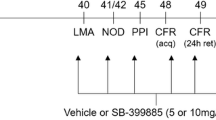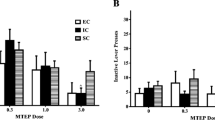Abstract
This study investigated central α2-adrenoceptor function in differentially reared rats. Rats reared from weaning were either housed singly or in groups of five. Measurements of spontaneous ambulatory activity at 4 weeks postweaning showed that isolates were more hyperactive on exposure to a novel environment than grouped rats. α2-Adrenoceptors were investigated using α2-adrenoceptor agonist-induced behaviours, [3H]-idazoxan binding and measurement of forskolin-stimulated cyclic AMP accumulation. Clonidine (0.001–1.0 mg/kg IP) induced mydriasis in both groups with no difference observed in the response between the isolation and group-reared animals. Clonidine (0.01–0.5 mg/kg IP) induced hypoactivity in both groups, with the effect significantly greater in the isolation-reared rats. Idazoxan markedly attenuated both responses, confirming their induction by α2-adrenoceptor stimulation. Clonidine-induced hypoactivity and mydriasis are mediated by pre- and postsynaptic α2-adrenoceptors, respectively; therefore the results suggest rats reared in isolation have enhanced presynaptic but unchanged postsynaptic α2-adrenoceptor function. Saturation binding experiments using [3H]-idazoxan were undertaken to determine α2-adrenoceptor number (Bmax) and affinity (Kd) in membranes prepared from the frontal cortex and hippocampus. Analysis of binding data revealed an increase in receptor number in the hippocampus of isolates. Cyclic AMP accumulation was measured in hippocampal slices from differentially reared rats. Isolation-rearing did not affect cyclic AMP accumulation in response to stimulation by forskolin (30 µM). However, the selective α2-adrenoceptor agonist, UK14304, produced a significantly greater inhibition of cyclic AMP accumulation in slices from isolated rats, confirming changes in α2-adrenoceptor function following isolation rearing.
Similar content being viewed by others
References
Altman J, Bayer SA (1975). Postnatal development of hippocampal dentate gyrus under normal and experimental conditions. In: Isaacson KL, Pribham KH (eds) The hippocampus: a comprehensive treatise, Vol. 1. Plenum Press, New York, pp 95–122
Anden NE, Brabowska M, Strombom U (1976). Different alpha-adrenoceptors in the central nervous system mediating biochemical and functional effects of clonidine and receptor blocking agents. Naunyn-Schmiedeberg's Arch Pharmacol 292:43–53
Benkirane S, Arbilla S, Langer SZ (1985) Supersensitivity of α2-adrenoceptor modulation of [3H]-5-HT release after noradrenergic denervation with DSP-4. Eur J Pharmacol 119:131–133
Berridge TL, Gadie B, Roach AG, Tulloch IF (1983) α-Adrenoceptor agonists induce mydriasis in the rat by an action within the central nervous system. Br J Pharmacol 78:507–515
Bickerdike MJ, Wright IK, Marsden CA (1993) Social isolation attenuates rat forebrain 5-HT release induced by KCl stimulation and exposure to a novel environment. Behav Pharmacol 4:231–236
Boyajian CL, Loughlin SE, Leslie FM (1987) Anatomical evidence for α2-adrenoceptor heterogeneity: differential autoradiographic distributions of [3H]-rauwolscine and [3H]-idazoxan in rat brain. J Pharmacol Exp Ther 241[3]:1079–1091
Brown CM, Mackinnon AC, McGrath JC, Spedding M, Kilpatrick AT (1990) α2-Adrenoceptor subtypes and imidazoline-like binding sites in the rat brain. Br J Pharmacol 99:803–809
Cador M, Robbins TW, Everitt BJ (1989) Involvement of the amygdala in stimulus-reward associations: interaction with the ventral striatum. Neuroscience 30:77–86
De Vos H, Convents A, De Keyser J, De Backer J-P, Van Megen IJB, Ebinger G, Vauquelin G (1991) Autoradiographic distribution of α2-adrenoceptors, NAIBS and 5-HT1A receptors in human brain using [3H]-idazoxan and [3H]-rauwolscine. Brain Res 566:13–20
Drew GM, Gower AJ, Marriott AS (1979) α2-Adrenoceptors mediate clonidine-induced sedation in the rat. Br J Pharmacol 67:133–141
Duman RS, Enna SJ (1986) A procedure for measuring α2-adrenergic receptor-mediated inhibition of cyclic AMP accumulation in rat brain slices. Brain Res 384:391–394
Einon DF, Morgan MJ (1978) Early social isolation produces enduring hyperactivity in the rat, but no effect upon spontaneous alternation. Q J Exp Psychol 30:151–156
Feuerstein TJ, Mutschler AL, Van Velthoven V, Schlicker E, Gothert M (1993) Endogenous noradrenaline activates α2-adrenoceptors on serotonergic nerve terminals in human and rat neocortex. J Neurochem 61:474–480
Fiala BA, Joyce JN, Greenough WT (1978) Environmental complexity modulates growth of granule cell dendrites in developing but not adult hippocampus of rats. Exp Neurol 59:372–383
Fulford AJ, Marsden CA (1993) Release of norepinephrine in vitro following isolation-rearing in the rat. Soc Neurosci Abstr 19[2]:1162
Heal DJ, Lister SL, Smith SL, Davies CL, Molyneux SG, Green AR (1983) Effects of acute and repeated administration of various antidepressant drugs on clonidine-induced hypoactivity in mice and rats. Neuropharmacology 22:483–492
Heal DJ, Prow MR, Buckett WR (1989) Clonidine-induced hypoactivity and mydriasis in mice are respectively mediated via preand postsynaptic α2-adrenoceptors in the brain. Eur J Pharmacol 170:19–28
Heal DJ, Butler SA, Prow MR, Buckett WR (1993) Quantification of presynaptic α2-adrenoceptors in rat brain after short-term DSP-4 lesioning. Eur J Pharmacol 249[1]:37–42
Heritch AJ, Henderson K, Westfall TC (1990) Effects of social isolation on catecholamine concentration and turnover in discrete areas of the rat brain. Brain Res 131:259–269
Hey JA, Gherezghiher T, Koss MC (1985) Studies on the mechanism of clonidine-induced mydriasis in the rat. Eur J Pharmacol 328:258–263
Hoehn-Saric R, Merchant AR, Keyser ML, Smith VK (1981) Effects of clonidine on anxiety disorders. Arch Gen Psychiatry 38:1278–1282
Huttner WB, Greengard P (1979) Multiple phosphorylation sites in protein I and their different regulation by cyclic AMP and calcium. Proc Natl Acad Sci USA 76:5402–5406
Jones GH, Marsden CA, Robbins TW (1990) Increased sensitivity to amphetamine and reward-related stimuli following social isolation in rats: possible disruption of dopamine-dependant mechanisms of nucleus accumbens. Psychopharmacology 102:364–372
Jones GH, Marsden CA, Robbins TW (1991) Behavioural rigidity and rule-learning deficits following isolation-rearing in the rat: neurochemical correlates. Behav Brain Res 43:35–50
Jones GH, Hernandez TD, Kendall DA, Marsden CA, Robbins TW (1992) Dopaminergic and serotonergic function following isolation rearing in rats. A study of behavioural responses and postmortem and in vivo neurochemistry. Pharmacol Biochem Behav 43[1]:17–35
Juraska JM, Henderson C, Muller J (1984) Differential rearing, experience, gender and radial maze performance. Dev Psychobiol 17:209–215
Koss MC (1979) Topical clonidine produces mydriasis by a central nervous system action. Eur J Pharmacol 55:305–310
Koss MC, Christensen MD (1979) Evidence for a central postsynaptic action of clonidine. Naunyn-Schmiedeberg's Arch Pharmacol 307:45–50
Koss MC, Gherezghiher T, Nomura A (1984) CNS adrenergic inhibition of parasympathetic oculomotor tone. J Auton Nerv Sys 10:55–68
Kraeuchi K, Gentsch C, Feer H (1981) Individually reared rats. Alteration in noradrenergic brain function. J Neural Transm 50:103–112
Kullback S (1968) Information statistics and theory. Raven Press, New York
Laverty R (1970) A comparison of the behavioural effects of some hypotensive imidazoline derivatives in rats. Eur J Pharmacol 9:163–169
Lowry OH, Rosebrough NJ, Farr AL, Randall RJ (1951) Protein measurements with the Folin phenol reagent. J Biol Chem 193:265–275
Mallard NJ, Hudson AL, Nutt DJ (1992) Characterisation and autoradiographical localisation of non-adrenoceptor idazoxan binding sites in the rat brain. Br J Pharmacol 106:1019–1027
McPherson GA (1985) Analysis of radioligand binding experiments: a collection of computer programs for IBM PC. J Pharmacol Methods 14:213–228
Morgan MJ, Einon DF (1975) Incentive motivation and behavioural inhibition in socially isolated rats. Physiol Behav 15:405–409
Morgan MJ, Einon DF, Nicholas D (1975) The effects of isolation-rearing on behavioural inhibition in the rat. Q J Exp Psychol 27:615–634
Morinan A, Parker V (1985) Are socially isolated rats anxious? Br J Pharmacol 86:460p
Mulder A, Schoffelmeer A, Stoof J (1990) On the role of adenylate cyclase in presynaptic modulation of neurotransmitter release mediated by monoamine and opioid receptors in the brain. Naunyn-Schmiedeberg's Arch Pharmacol 337:477–483
Munson PJ, Rodbard D (1980) LIGAND: a versatile computerised approach for the characterisation of ligand binding systems. Anal Biochem 107:220–239
Oehler J, Jahkel M, Schmidt J (1987) Neuronal transmitter sensitivity after social isolation in rats. Physiol Behav 41:187–191
Osman OT, Rudorfer MV, Potter WZ (1989) Idazoxan: a selective α2-antagonist and effective sustained antidepressant in two bipolar depressed patients. Arch Gen Psychiatry 46:958–959
Parker V, Morinan A (1986) The socially-isolated rat as a model for anxiety. Neuropharmacology 25:663–664
Ramdine R, Galzin A-M, Langer SZ (1989) Involvement of adenylate cyclase and protein kinase C in the α2-adrenoceptor-mediated inhibition of noradrenaline and 5-hydroxytryptamine release in rat hypothalamic slices. Naunyn Schmiedebergs Arch Pharmacol 340:386–395
Redmond DE, Huang YH (1979) New evidence for a locus coeruleus-norepinephrine connection with anxiety. Life Sci 25:2149–2162
Robbins TW (1992) Are animal models of mental illness viable? In: Elliott JM, Heal DJ, Marsden CA (eds) Experimental approaches to anxiety and depression. Wiley, Chichester, pp 219–231
Sahakian BJ, Robbins TW, Morgan MJ, Iversen SD (1975) The effects of psychomotor stimulants on stereotypy and locomotor activity in socially deprived and control rats. Brain Res 84:195–205
Schoffelmeer ANM, Wilrenga EA, Mulder AH (1986) Role of adenylate cyclase in presynaptic α2-adrenoceptor and μ-opioid receptor mediated inhibition of [3H]-noradrenaline release from rat brain cortex slices. J Neurochem 46:711–717
Stanford SC, Parker V, Morinan A (1988) Deficits in exploratory behaviour in socially-isolated rats are not accompanied by changes in cerebral cortical adrenoceptor binding. J Affect Dis 15:175–180
Syme LA (1973) Social isolation at weaning, some effects on two measures of activity. Anim Learn Behav 1:161–163
Thoa NB, Tizabi Y, Jacobowitz DM (1976) The effect of prolonged isolation on the catecholamine and serotonin concentrations of discrete areas of the rat brain. In: Usdin E, Kretnansky R, Kopin IJ (eds) Catecholamines and stress. Pergamon Press, Oxford, pp 61–66
Thoa NB, Tizabi Y, Jacobowitz DM (1977) The effect of isolation on catecholamine concentration and turnover in discrete areas of the rat brain. Brain Res 131:259–269
U'Prichard DC, Mitrius JC, Kahn DJ, Perry BD (1983) The α2-adrenergic receptor: multiple affinity states and regulation of a receptor inversely coupled to adenylate cyclase. Biochem Psychopharmacol 36:53–72
Walland A, Kobinger W (1971) On the problem of tolerance of 2-(2,6-dichlorophenylamino)-2-imidazoline. Arzneimittelforschung 21:61–65
Weinstock M, Speiser Z, Ashkenazi R (1978) Changes in brain catecholamine turnover and receptor sensitivity induced by social deprivation in rats. Psychopharmacology 56:205–209
Wright IK, Upton N, Marsden CA (1991a) Resocialisation of isolation-reared rats does not alter their anxiogenic profile on the elevated X-maze model of anxiety. Physiol Behav 50:1129–1132
Wright IK, Ismail H, Upton N, Marsden CA (1991b) Effect of isolation-rearing on 5-HT agonist-induced responses in the rat. Psychopharmacology 105:259–263
Zebrowska-Lupina I, Przegalinski E, Sloniec M, Kleinrok Z (1977) Clonidine-induced locomotor hyperactivity in rats. The role of postsynaptic α-adrenoceptors. Naunyn-Schmiedeberg's Arch Pharmacol 297:227–231
Author information
Authors and Affiliations
Rights and permissions
About this article
Cite this article
Fulford, A.J., Butler, S., Heal, D.J. et al. Evidence for altered α2-adrenoceptor function following isolation-rearing in the rat. Psychopharmacology 116, 183–190 (1994). https://doi.org/10.1007/BF02245061
Received:
Revised:
Issue Date:
DOI: https://doi.org/10.1007/BF02245061




